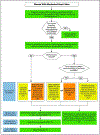Management of Women With Congenital or Inherited Cardiovascular Disease From Pre-Conception Through Pregnancy and Postpartum: JACC Focus Seminar 2/5
- PMID: 33832605
- PMCID: PMC8061781
- DOI: 10.1016/j.jacc.2021.02.026
Management of Women With Congenital or Inherited Cardiovascular Disease From Pre-Conception Through Pregnancy and Postpartum: JACC Focus Seminar 2/5
Abstract
Maternal morbidity and mortality continue to rise in the United States, with cardiovascular disease as the leading cause of maternal deaths. Congenital heart disease is now the most common cardiovascular condition encountered during pregnancy, and its prevalence will continue to grow. In tandem with these trends, maternal cardiovascular health is becoming increasingly complex. The identification of women at highest risk for cardiovascular complications is essential, and a team-based approach is recommended to optimize maternal and fetal outcomes. This document, the second of a 5-part series, will provide practical guidance from pre-conception through postpartum for cardiovascular conditions that are predominantly congenital or heritable in nature, including aortopathies, congenital heart disease, pulmonary hypertension, and valvular heart disease.
Keywords: aortopathy; cardio-obstetrics; congenital; pregnancy; pulmonary hypertension.
Copyright © 2021 American College of Cardiology Foundation. Published by Elsevier Inc. All rights reserved.
Conflict of interest statement
Funding Support and Author Disclosures Dr. Bairey Merz has served as a consultant for Abbott and Sanofi; and has served on the Board of Directors for iRhythm. Dr. Bello is supported by the National Institutes of Health/National Heart, Lung, and Blood Institute (K23 HL136853-03, R01 HL153382-01). Dr. Gomberg-Maitland has received research grant support to GWU-MFA from Acceleron, Bayer, Complexa, and United Therapeutics; and has served as a consultant for Actelion, Altavant, Acceleron, Bayer, Gilead, Insemed, Reata, and United Therapeutics. Dr. Park has served as a consultant for Abbott. All other authors have reported that they have no relationships relevant to the contents of this paper to disclose.
Figures













References
-
- Hirshberg A, Srinivas SK. Epidemiology of maternal morbidity and mortality. Seminars in perinatology 2017;41:332–337. - PubMed
-
- Canobbio MM, Warnes CA, Aboulhosn J et al. Management of Pregnancy in Patients With Complex Congenital Heart Disease: A Scientific Statement for Healthcare Professionals From the American Heart Association. Circulation 2017;135:e50–e87. - PubMed
-
- Stout KK, Daniels CJ, Aboulhosn JA et al. 2018 AHA/ACC Guideline for the Management of Adults With Congenital Heart Disease: A Report of the American College of Cardiology/American Heart Association Task Force on Clinical Practice Guidelines. J Am Coll Cardiol 2018. - PubMed
-
- ACOG Practice Bulletin No. 212: Pregnancy and Heart Disease. Obstetrics and gynecology 2019;133:e320–e356. - PubMed
-
- Lansman SL, Goldberg JB, Kai M, Tang GH, Malekan R, Spielvogel D. Aortic surgery in pregnancy. The Journal of thoracic and cardiovascular surgery 2017;153:S44–S48. - PubMed
Publication types
MeSH terms
Grants and funding
LinkOut - more resources
Full Text Sources
Other Literature Sources

